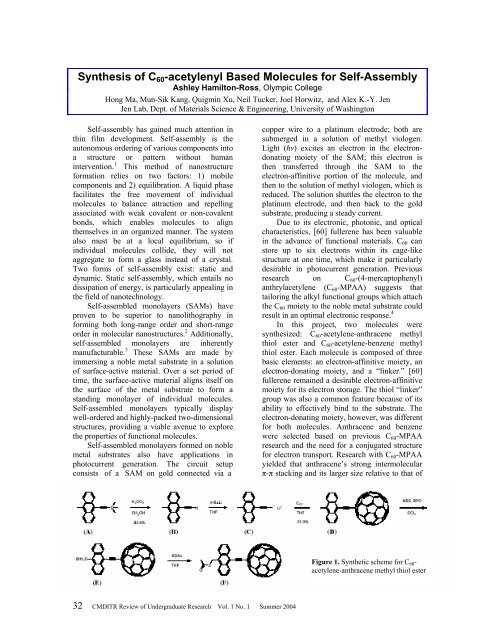CMDITR Review of Undergraduate Research - Pluto - University of ...
CMDITR Review of Undergraduate Research - Pluto - University of ...
CMDITR Review of Undergraduate Research - Pluto - University of ...
You also want an ePaper? Increase the reach of your titles
YUMPU automatically turns print PDFs into web optimized ePapers that Google loves.
Synthesis <strong>of</strong> C 60 -acetylenyl Based Molecules for Self-Assembly<br />
Ashley Hamilton-Ross, Olympic College<br />
Hong Ma, Mun-Sik Kang, Quigmin Xu, Neil Tucker, Joel Horwitz, and Alex K.-Y. Jen<br />
Jen Lab, Dept. <strong>of</strong> Materials Science & Engineering, <strong>University</strong> <strong>of</strong> Washington<br />
Self-assembly has gained much attention in<br />
thin film development. Self-assembly is the<br />
autonomous ordering <strong>of</strong> various components into<br />
a structure or pattern without human<br />
intervention. 1 This method <strong>of</strong> nanostructure<br />
formation relies on two factors: 1) mobile<br />
components and 2) equilibration. A liquid phase<br />
facilitates the free movement <strong>of</strong> individual<br />
molecules to balance attraction and repelling<br />
associated with weak covalent or non-covalent<br />
bonds, which enables molecules to align<br />
themselves in an organized manner. The system<br />
also must be at a local equilibrium, so if<br />
individual molecules collide, they will not<br />
aggregate to form a glass instead <strong>of</strong> a crystal.<br />
Two forms <strong>of</strong> self-assembly exist: static and<br />
dynamic. Static self-assembly, which entails no<br />
dissipation <strong>of</strong> energy, is particularly appealing in<br />
the field <strong>of</strong> nanotechnology.<br />
Self-assembled monolayers (SAMs) have<br />
proven to be superior to nanolithography in<br />
forming both long-range order and short-range<br />
order in molecular nanostructures. 2 Additionally,<br />
self-assembled monolayers are inherently<br />
manufacturable. 3 These SAMs are made by<br />
immersing a noble metal substrate in a solution<br />
<strong>of</strong> surface-active material. Over a set period <strong>of</strong><br />
time, the surface-active material aligns itself on<br />
the surface <strong>of</strong> the metal substrate to form a<br />
standing monolayer <strong>of</strong> individual molecules.<br />
Self-assembled monolayers typically display<br />
well-ordered and highly-packed two-dimensional<br />
structures, providing a viable avenue to explore<br />
the properties <strong>of</strong> functional molecules.<br />
Self-assembled monolayers formed on noble<br />
metal substrates also have applications in<br />
photocurrent generation. The circuit setup<br />
consists <strong>of</strong> a SAM on gold connected via a<br />
copper wire to a platinum electrode; both are<br />
submerged in a solution <strong>of</strong> methyl viologen.<br />
Light (hv) excites an electron in the electrondonating<br />
moiety <strong>of</strong> the SAM; this electron is<br />
then transferred through the SAM to the<br />
electron-affinitive portion <strong>of</strong> the molecule, and<br />
then to the solution <strong>of</strong> methyl viologen, which is<br />
reduced. The solution shuttles the electron to the<br />
platinum electrode, and then back to the gold<br />
substrate, producing a steady current.<br />
Due to its electronic, photonic, and optical<br />
characteristics, [60] fullerene has been valuable<br />
in the advance <strong>of</strong> functional materials. C 60 can<br />
store up to six electrons within its cage-like<br />
structure at one time, which make it particularly<br />
desirable in photocurrent generation. Previous<br />
research on C 60 -(4-mercaptophenyl)<br />
anthrylacetylene (C 60 -MPAA) suggests that<br />
tailoring the alkyl functional groups which attach<br />
the C 60 moiety to the noble metal substrate could<br />
result in an optimal electronic response. 4<br />
In this project, two molecules were<br />
synthesized: C 60 -acetylene-anthracene methyl<br />
thiol ester and C 60 -acetylene-benzene methyl<br />
thiol ester. Each molecule is composed <strong>of</strong> three<br />
basic elements: an electron-affinitive moiety, an<br />
electron-donating moiety, and a “linker.” [60]<br />
fullerene remained a desirable electron-affinitive<br />
moiety for its electron storage. The thiol “linker”<br />
group was also a common feature because <strong>of</strong> its<br />
ability to effectively bind to the substrate. The<br />
electron-donating moiety, however, was different<br />
for both molecules. Anthracene and benzene<br />
were selected based on previous C 60 -MPAA<br />
research and the need for a conjugated structure<br />
for electron transport. <strong>Research</strong> with C 60 -MPAA<br />
yielded that anthracene’s strong intermolecular<br />
π-π stacking and its larger size relative to that <strong>of</strong><br />
Figure 1. Synthetic scheme for C 60 -<br />
acetylene-anthracene methyl thiol ester<br />
32 <strong>CMDITR</strong> <strong>Review</strong> <strong>of</strong> <strong>Undergraduate</strong> <strong>Research</strong> Vol. 1 No. 1 Summer 2004




